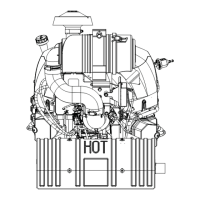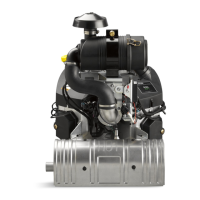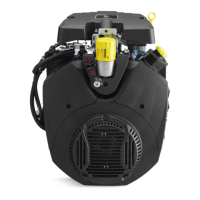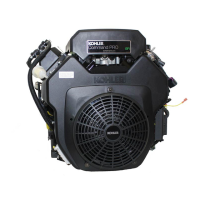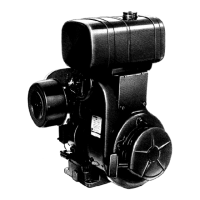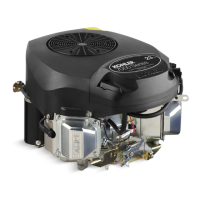11762 690 05 Rev. H KohlerEngines.com
Electrical System
i. If voltage increases to between 13-15 VDC,
system is working correctly.
ii. If voltage increases to 15.5 VDC or higher,
system is overcharging. Replace rectifi er-
regulator.
iii. If voltage stays at 12.5 VDC or decreases,
charging system is NOT operating, proceed to
step 5.
c. If a carbon pile test tool is available, connect tool
to battery posts (Red positive +/Black negative -)
turn load knob counterclockwise (no load). Start
and run engine at high speed (3600 RPM
optimal), adjust carbon pile voltage to 12 volts
and observe amperage on amp meter. Displayed
amperage should be near or at maximum rated
system output. (Follow tool directions for carbon
pile test procedures.)
Condition Conclusion
Charge rate increases
when load is applied.
Charging system is OK
and battery was fully
charged.
Charge rate does not
increase when load is
applied
Test stator and rectifi er-
regulator (steps 5-8).
5. With engine off , remove terminal block cover from
rectifi er-regulator and inspect ring terminals and
rectifi er-regulator studs for corrosion/arcing/damage.
Repair/replace as needed. If OK, proceed to next
test.
6. Label each yellow stator wire (1, 2, 3) on ring
terminal sheathing. Remove nuts retaining stator
eyelets and cover each ring terminal with electrical
tape, to ensure no accidental contact can be made.
NOTE: DVOM must be able to read to 0.05 ohms.
Set DVOM to AC volts, place test lead to each
yellow stator wire ring terminal (under tape). Run
engine at high speed and monitor voltage. Measure
between each stator lead and ground (1-ground,
2-ground, 3-ground).
Condition Conclusion
Voltage is 17 volts AC or
more.
Stator is OK.
Voltage is less than 17
volts AC.
Stator is faulty. Continue
with steps 7 and 8).
7. With engine off and stator ring terminals removed
from rectifi er-regulator, check for resistance/
continuity between across stator leads (yellow wires;
1-2, 1-3, 2-3).
Condition Conclusion
Resistance is 0.1/0.2
ohms.
Stator coil is OK.
Resistance is 0 ohms. Stator is shorted; replace.
Resistance is infi nity
ohms/no continuity.
Stator is open; replace.
8. With engine off and stator ring terminals removed
from rectifi er-regulator, check for resistance/
continuity from stator leads (yellow wires) to ground.
Condition Conclusion
Resistance is infi nity ohms
(no continuity).
Stator is OK (not shorted
to ground).
Resistance (or continuity)
measured.
Stator leads are shorted to
ground; replace.
9. If stator tests good (steps 5-8), but system was
identifi ed in step 4 as not working, failure is likely
with rectifi er-regulator. Replace rectifi er-regulator,
retest system to confi rm repairs (step 4).
FUSES (High Output Charging System)
Engines equipped with a high output charging system
have one (1) large blade type automotive fuse, in
addition to three (3) blade type automotive fuses.
However, 30-amp fuse is then nonfunctional as 30-
amp charging circuit has been disabled. Purple charge
wire ring terminals in main engine wiring harness are
completely sealed and retained using a special heat
shrink cap for non use. No service is required for this
circuit.
Replacement fuses must have same rating as blown
fuse. Use fuse chart below to determine correct fuse.
Wire Color Fuse Rating
2 Purple Wires 30-amp Fuse
1 Red Wire w/Black Stripe
1 Red Wire w/White Stripe
10-amp Fuse
2 Red Wires 10-amp Fuse
High Output Charging System adds
In separate wiring harness;
when OEM supplied, refer
to your equipment manual
for fuse detail.
Kohler 60-amp Fuse
Fuse Replacement
1. Shut engine off and remove key.
2. Locate fuse holders.
3. Remove fuse cover and pull out fuse.
4. Inspect fuse for a solid fusible link or a broken
fusible link. Replace fuse if fusible link is broken. If
you are not sure if fusible link is broken, replace
fuse.
5. Insert fuse into fuse holder until it is seated properly.
Install fuse cover.
6. If replacement fuse fails, there is a problem within
circuit. Diagnostics are required. Identify which
circuit is aff ected (see EFI System for electrical
schematic) by identifying failed fuse/circuit. Perform
troubleshooting procedures appropriate for circuit
fuse that failed.
7. Install fuse holder into fuse cover.
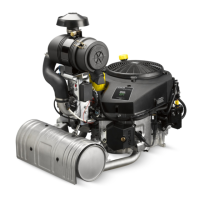
